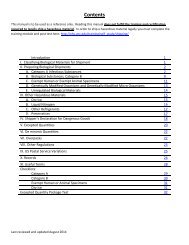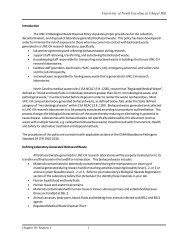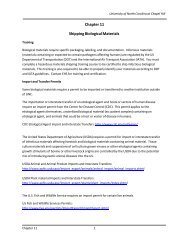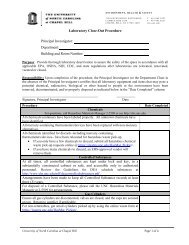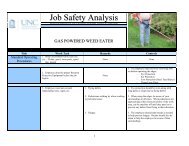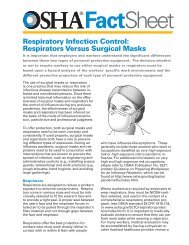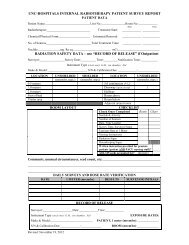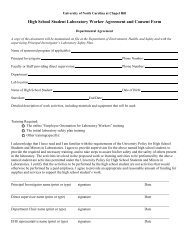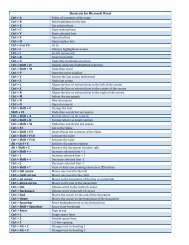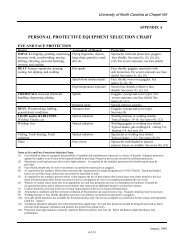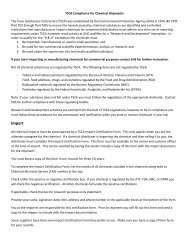Indoor Air Quality Policy - Department of Environment, Health and ...
Indoor Air Quality Policy - Department of Environment, Health and ...
Indoor Air Quality Policy - Department of Environment, Health and ...
Create successful ePaper yourself
Turn your PDF publications into a flip-book with our unique Google optimized e-Paper software.
University <strong>of</strong> North Carolina at Chapel HillAnother consideration is the magnitude <strong>of</strong> the probable source <strong>of</strong> the suspected contaminant. Asmall area <strong>of</strong> old carpeting is less likely to be a problematic mold source than a larger area whereflooding had occurred.Area <strong>of</strong> ConcernDuring its investigation, EHS will delineate an area <strong>of</strong> concern for indoor air quality problems <strong>and</strong>possible remediation. The area <strong>of</strong> concern will be delineated according to the locations <strong>of</strong>complainants, the probable source <strong>of</strong> the suspected contaminant, the design <strong>of</strong> the HVAC system<strong>and</strong> physical barriers.Remedial MeasuresRemedial measures may be confined <strong>and</strong> temporary, or as extensive as renovation <strong>of</strong> a building’sheating, ventilation <strong>and</strong> air conditioning (HVAC) system. Less extensive remedial measures includeopening windows, better housekeeping, replacing furniture, cleaning mildew <strong>of</strong>f <strong>of</strong> pipes, installingportable dehumidifiers or air cleaners, cleaning window air conditioners <strong>and</strong> replacing carpet withtile.Sick Building SyndromeWhen the symptoms <strong>of</strong> respiratory tract <strong>and</strong> eye irritation, headaches <strong>and</strong> fatigue are experienced bya sizable percentage <strong>of</strong> building occupants (usually more than 20 percent), the situation has becomeknown as Sick Building Syndrome (SBS). Specific causes <strong>of</strong> SBS remain unknown. Insufficient freshair (outdoor air) being brought inside is sometimes associated with buildings with SBS. A singlecause for SBS is unlikely. Many hypotheses must be considered in determining the cause <strong>of</strong>complaints in any particular building, including ventilation rates, ventilation system maintenance <strong>and</strong>type, <strong>and</strong> a multitude <strong>of</strong> irritants from occupant activities, microbial contamination, <strong>and</strong> <strong>of</strong>f-gassingfrom building furnishings.Building-Related Illness (BRI)Building-related illness is very rare, but <strong>of</strong>ten more serious than symptoms reported in SBS, <strong>and</strong> mayaffect only a small number <strong>of</strong> building occupants. BRI is characterized by a distinguishable set <strong>of</strong>common occupant symptoms, <strong>of</strong>ten accompanied by physical signs <strong>and</strong> clinical abnormalities. BRI isconfirmed by a physicians diagnosis <strong>and</strong> may include infections such as legionellosis, toxicsyndromes associated with exposure to chemical or physical agents, <strong>and</strong> hypersensitivity diseases,including hypersensitivity pneumonitis, “humidifier fever,” asthma <strong>and</strong> allergic rhinitis.PREVENTION OF INDOOR AIR QUALITY PROBLEMSMany IAQ issues can be avoided with timely maintenance <strong>and</strong> repair building HVAC systems <strong>and</strong>rapid response to water intrusion into a building. Water damaged areas must be dried in 24 hours toprevent the initiation <strong>of</strong> fungal growth. Building occupants should notify Facility Services as soon aspossible <strong>of</strong> plumbing, ro<strong>of</strong> <strong>and</strong> foundation leaks or HVAC malfunctions. Facility Services <strong>and</strong> EHSrespond quickly to these problems.EHS INDOOR AIR QUALITY INVESTIGATIONEvaluation <strong>of</strong> building related complaints requires the cooperative effort <strong>of</strong> the complainant, theFacilities Services <strong>and</strong> <strong>Department</strong> <strong>of</strong> <strong>Environment</strong>, <strong>Health</strong> <strong>and</strong> Safety. Following the initial0-00-2June 2002
University <strong>of</strong> North Carolina at Chapel Hillcomplaint, the EHS will interview the complainant to determine if his or her symptoms arepotentially related to IAQ problems. When such a potential exists, EHS will conduct an IAQinvestigation with appropriate Facilities Services staff according to the following procedures. Theinvestigation may lead to plans for remediation.Identification <strong>of</strong> IAQ ProblemsBuilding occupants who experience irritations that may be related indoor air quality should completea Request for <strong>Indoor</strong> <strong>Air</strong> <strong>Quality</strong> Investigation (Appendix A) <strong>and</strong> forwarded it to EHS for review.An EHS Industrial Hygienist will review the form <strong>and</strong> interview the complainant to determine whatfurther action is needed.Complaints received by Facilities Services, involving specific symptoms, should be forwardeddirectly to EHS for review. Facility engineers <strong>and</strong> campus maintenance workers who identify IAQproblems or risks (e.g., odors, significant mold growth, faulty building humidification systems)should contact EHS directly.Initial On-Site IAQ InvestigationWhen notified <strong>and</strong> if warranted, an EHS Industrial Hygienist will conduct an initial on-siteinvestigation. The following conditions will typically be evaluated:• Percentage <strong>of</strong> outside air being supplied to building• Location <strong>of</strong> outside air intake(s)• Immediate outside environment• Ventilation rate• Operation <strong>and</strong> maintenance <strong>of</strong> HVAC system• Relative humidity• Temperature• Carbon dioxide level• Signs <strong>of</strong> water intrusion including plumbing, ro<strong>of</strong> <strong>and</strong> foundation leaksEHS will also evaluate the work area <strong>and</strong> building for probable sources <strong>of</strong> contaminants, such aschemical use <strong>and</strong> storage; general housekeeping; recent renovations <strong>and</strong>/or new furnishings,activities in work area, <strong>and</strong> the building HVAC system. Some investigations will require theassistance <strong>of</strong> Facilities Services.Phase II IAQ InvestigationIn some cases, the initial investigation indicates the need for a Phase II IAQ investigation to providemore detailed information regarding the nature <strong>of</strong> the problem. This phase <strong>of</strong> the investigation mayinclude the following:• Monitoring for chemical contaminants• Bioaerosol monitoring• Detailed HVAC evaluations• Medical examinations <strong>and</strong>/or testing at the University Employee Occupational <strong>Health</strong> Clinic (foremployees) or Student <strong>Health</strong> Service (for students).0-00-3June 2002
University <strong>of</strong> North Carolina at Chapel HillLimitations <strong>of</strong> IAQ InvestigationsSampling methodologies <strong>and</strong> acceptable limits have been established for many contaminants.However, occupants may continue to experience discomfort at contaminant levels below st<strong>and</strong>ardsfor occupational exposure. Also, individual sensitivities vary.Sampling <strong>and</strong> measuring indoor mold contamination on surfaces is <strong>of</strong> limited value because mold isfound in virtually all environments, <strong>and</strong> because no consensus or regulatory st<strong>and</strong>ards have beenestablished. One <strong>of</strong> the problems with establishing st<strong>and</strong>ards is that individual sensitivity to moldvaries greatlyBecause <strong>of</strong> the small number <strong>of</strong> occupants <strong>and</strong> uncontrolled conditions, epidemiological studies are<strong>of</strong> no or very limited value.EHS IAQ INVESTIGATION REPORT AND REMEDIAL MEASURESEHS will prepare a written report <strong>of</strong> investigation results, including conclusions regarding possiblecauses <strong>of</strong> the IAQ problems. Copies <strong>of</strong> the IAQ investigation report will be forwarded to thecomplainant <strong>and</strong> his or her supervisor, <strong>and</strong> other associated units.Remedial Measure DecisionmakingWhen indicated, EHS will recommend remedial measures. These will be reviewed by the UniversityEmployee Occupational <strong>Health</strong> Clinic (UEOHC), the complaitant’s supervisor, <strong>and</strong>/or FacilitiesServices as needed. When visual observation finds significant mold in water-damaged environments,controlling <strong>and</strong> eliminating mold growth will be recommended. EHS will determine if other IAQrisks are actionable by evaluating four variables:• Probable source <strong>of</strong> a suspected contaminant, <strong>and</strong> its extent or magnitude• Number <strong>of</strong> occupants with symptoms appropriate for the suspected contaminant, <strong>and</strong> theseverity <strong>of</strong> their symptoms• The availability <strong>of</strong> reasonable <strong>and</strong> effective measures to mitigate the suspected contaminant• Time <strong>of</strong> exposure <strong>of</strong> the symptomatic employees to the suspected contaminantWhen the source <strong>of</strong> an indoor air quality problem <strong>and</strong> appropriate remedial measures are difficult todiscern, recommendations will rely on the judgment <strong>of</strong> Facilities Services engineers <strong>and</strong> EHS staff.Implementation <strong>of</strong> Occupant-Responsible Remedial MeasuresRemedial action that needs to be implemented by the supervisor should be completed within areasonable time. This type <strong>of</strong> action could include general housekeeping, the purchase <strong>of</strong> anon-fabric chair, or the relocation <strong>of</strong> printers or paper storage.Implementation <strong>of</strong> Other Remedial MeasuresIf the remedial measures require building maintenance or repair, Facilities Services or the<strong>Department</strong> <strong>of</strong> Housing <strong>and</strong> Residential Education (as appropriate) will work with the EHS <strong>and</strong>building occupant to implement them.0-00-4June 2002
University <strong>of</strong> North Carolina at Chapel HillExcept for very small projects, areas found to have an indoor air quality problem are prioritized forremediation <strong>and</strong> categorized as “Class A-High Priority,” “Class B-Further Evaluation Needed,” <strong>and</strong>“Class C-IAQ Improvements Already Funded.” This list is reviewed annually by the UniversitySafety <strong>and</strong> Security Committee, which facilitates the completion <strong>of</strong> Class A projects as funds becomeavailable.During extensive remediation, the affected department should work with Human ResourcesAdministration to arrange a suitable alternative working arrangements for employees.AFTER ACTION EHS REVIEWThe complainant’s department <strong>and</strong>/or Facilities Services will notify EHS when remedial actionshave been completed. EHS will inspect the work area after remedial measures have been completedto ensure that recommendations have been implemented <strong>and</strong> to evaluate their effectiveness. Thebuilding occupant <strong>and</strong> his or her department will be responsible for reporting any further problemsto EHS after this follow-up.BUIDING OCCUPANTS WITH CONTINUING IAQ COMPLAINTSStudents with Continuing IAQ ComplaintsStudents who experience symptoms after the remedial measures have been implemented should tothe Student <strong>Health</strong> Service (966-2281) for a medical evaluation. The Student <strong>Health</strong> Service willwork with EHS <strong>and</strong>, when appropriate, the <strong>Department</strong> <strong>of</strong> Housing <strong>and</strong> Residential Education tomake recommendations for any additional follow-up.Employees with Continuing IAQ ComplaintsEmployees who experience symptoms after the remedial measures have been implemented shouldreport to their supervisor <strong>and</strong> call the UEOHC (6-9119) for a medical evaluation. If an employeepresents medical documentation to his or her supervisor from the employee’s personal physician,the supervisor should forward the note to the UEOHC. The UEOHC will send the employee’spersonal physician an “Evaluation <strong>of</strong> Illness Believed Related to <strong>Indoor</strong> <strong>Air</strong> <strong>Quality</strong> At Work”(Appendix B) to complete. This evaluation will assist in specifying the cause <strong>of</strong> the discomfort forthe employee <strong>and</strong> will assist the University in taking remedial action.After review <strong>of</strong> all reports the UEOHC will make its recommendations to the employee, his or hersupervisor, <strong>and</strong> EHS for any additional follow-up. The affected department should not implementany permanent accommodations that the employee’s physician has requested until UEOHCcompletes an occupational medical assessment <strong>and</strong> reviews EHS IAQ investigation reports.If UEOHC deems that the medical accommodation for the employee’s position is necessary, theemployee’s supervisor should contact the University’s ADA Officer. The ADA Officer will workwith the employee’s department in determining what accommodations are reasonable under thecurrent essential job functions for that employee.0-00-5June 2002
University <strong>of</strong> North Carolina at Chapel HillFOR FURTHER ASSISTANCEThe Office <strong>of</strong> Human Resources can assist departments in determining the essential functions <strong>of</strong> aposition <strong>and</strong> can help explore various working arrangements to help meet the employee’s <strong>and</strong>department’s needs.The Office <strong>of</strong> University Counsel can answer questions from supervisors <strong>and</strong> managers about therequirements <strong>of</strong> the ADA <strong>and</strong> the North Carolina Persons with Disabilities Protection Act, <strong>and</strong> canprovide additional interpretive advice on employer obligations under these laws.Approved by the University Safety <strong>and</strong> Security Committee, 26 June 2002Approved by Chancellor James Moeser, July 20020-00-6June 2002



